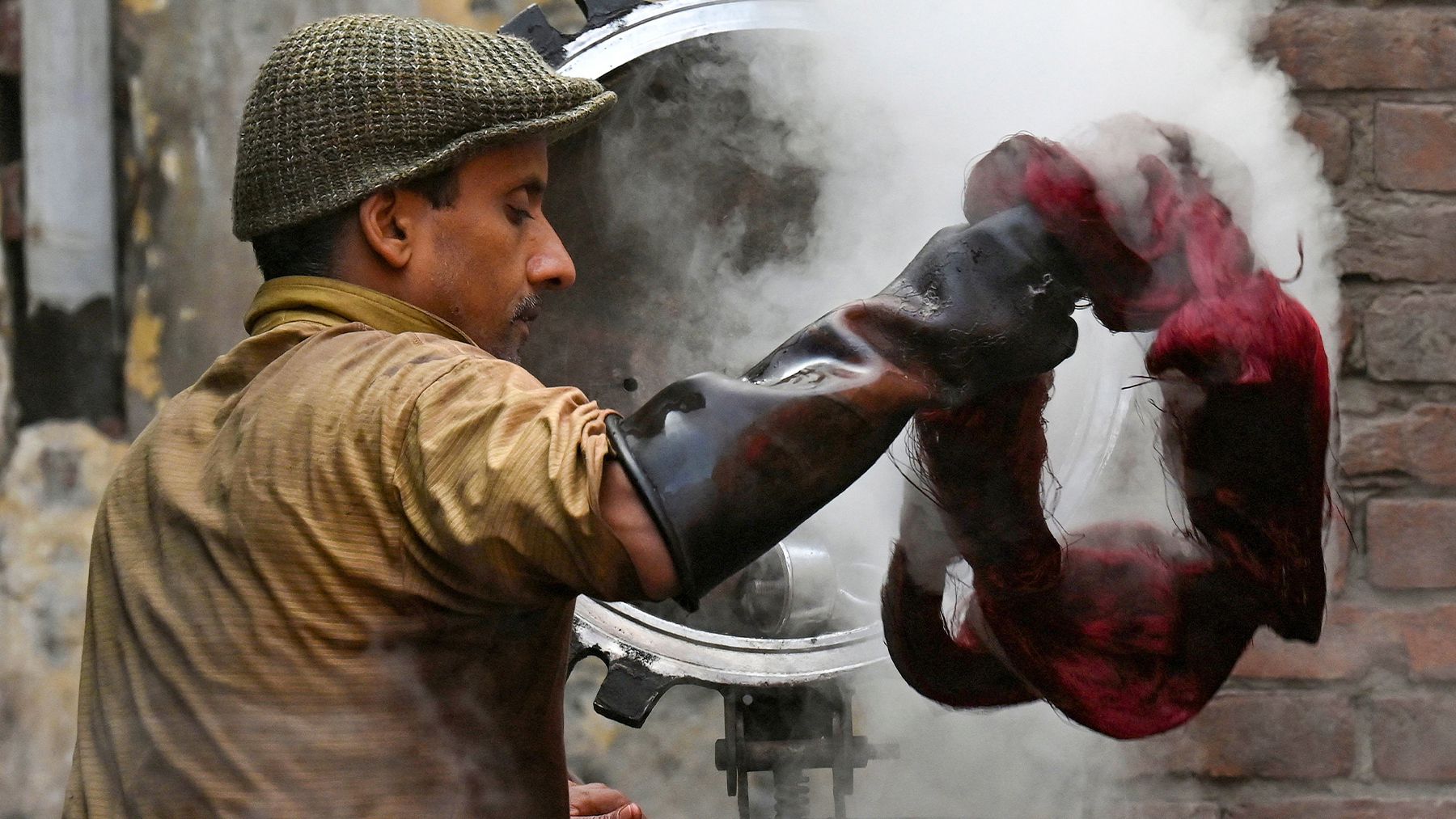
Over the last 18 months, some of fashion’s most powerful businesses have begun quietly pressing their suppliers to get coal out of factories in the coming years, or risk losing business.
The growing pressure reflects public pledges fashion giants including H&M Group, Puma and Lululemon have made as part of the UN Fashion Charter for Climate Action — the industry’s flagship climate initiative — to stop onboarding new suppliers using coal to generate the high temperatures needed to dye and treat fabrics. They’ve committed to ridding their supply chains of boilers that use the fossil fuel entirely by 2030.
The effort is critical if the industry is to have any hope of taming its greenhouse gas emissions and staying in line with globally agreed goals to stave off the worst effects of climate change.
Coal is one of the dirtiest fuels around, emitting more carbon when it’s burned than either oil or natural gas. It’s a major part of the energy mix in large fashion manufacturing hubs like China, India and Vietnam. But the industry’s focus is the thousands of coal-fired boilers used for energy-intensive wet processing in fabric mills around the world, where brands have greater influence.
“[Coal], especially on-site coal — that is priority number one,” said Betsy Blaisdell, manager of environmental stewardship at consultancy Guidehouse, which works with brands including H&M Group and initiatives like the Fashion Pact. “When you remove coal from the mix, you get to see carbon-emission reductions of 70 percent plus.”
The challenge is that coal is cheap, accessible and built into the industry’s existing infrastructure. Alternatives require upfront investment, come with their own trade offs and face a range of technological and practical hurdles, from cost to availability.
“[The brands] sit in the US and Europe and say all factories should remove coal boilers. It sounds like a fantastic idea, but it’s not realistic on the ground,” said Vidhura Ralapanawe, head of sustainability and innovation at Hong Kong-based sourcing and supply chain management business Epic Group, which is also a Fashion Charter signatory. “We really don’t have a good apparel sector decarbonisation roadmap.”
Imperfect Solutions
Just understanding the scope of the problem is difficult. Boilers are typically found in fabric mills, where energy-intensive processes to dye and treat textiles take place. But most brands have little notion of where the materials they use come from, let alone a strategy to support these businesses in a shift away from coal.
Leading brands and manufacturers are already working to reduce their reliance on the fuel, but all recognise there is no simple silver bullet solution. Boilers are difficult to electrify, and while the technology to do so is emerging, it only really solves the underlying problem if the electricity grids aren’t running on coal.
Pakistan-based denim manufacturer Artistic Milliners is planning to spend some $30 million on decarbonisation initiatives. The company has installed solar panels on its factory roofs and it’s adapting its boilers to run on natural gas or biomass from agricultural waste, instead of coal. But its renewable capacity is insufficient to fully run its facilities, let alone power energy-hungry boilers. Meanwhile, coal alternatives are more expensive, harder to come by and have their own environmental baggage.
“We can set up wind power, solar power, but we cannot utilise more space than we already have for on-site power,” said responsible business projects lead Saqib Sohail. “When you go to other options, like biomass, it’s not every area in the country that you can get supply… [and it] cost us a lot because coal in Pakistan is cheaper.”
To get rid of coal, the industry has to solve these challenges at scale. To meet its climate commitments, it has to do it fast.
Despite the issues, many see a shift to less polluting fuels as the most realistic way forward for now because it doesn’t require hefty investment in new technologies or infrastructure. Companies including Puma and H&M Group are encouraging their suppliers to switch to biomass where possible, to avoid replacing coal with natural gas, another fossil fuel.
But biomass can be generated from a range of sources, including wood pellets that have been linked to deforestation. Just like coal, burning it can cause heavy air pollution. Access to alternative supplies, like agricultural waste, is seasonal and very local. Demand is increasing as other industries also look to decarbonise, raising concerns that fuel crops could displace food. Standards for responsible biomass don’t currently exist, though the Fashion Charter is working to get the industry to agree on some.
On the other hand, more game-changing alternatives are much costlier and rely on technologies that are just beginning to emerge.
“We’re looking at unprecedented goals,” said Gauri Sharma, sustainability communications and innovation lead at Indian manufacturing giant Shahi Exports. “What’s the alternative to biomass, coal, natural gas? It’s electrification, and that’s going to take huge investment.”
Who Pays?
Climate action isn’t the only area where brands have upped the pressure on suppliers in recent months. Volatile markets and inventory woes in the wake of the pandemic have created whipsawing demand and intense pricing pressure that suppliers say make it tough to commit to big eco-investments or even shoulder the cost of substituting alternative fuels for coal.
“Right now there’s severe demand contraction in orders. There is a massive fight for discounting. So if I price myself focusing on climate, I will not survive,” said Ralapanawe.
Brands pushing to remove coal boilers from their manufacturing base say they are working with suppliers to help make the shift. H&M Group has committed $300 million a year to projects that will reduce its emissions, including phasing out coal. It has partnered with Guidehouse to develop projects that blend efficiency initiatives with more costly programmes to guarantee a return and entice brands and others to co-invest with their suppliers.
But most companies aren’t putting their own cash into decarbonisation programmes in businesses they don’t own or operate, pointing instead to knowledge-sharing support, efforts to help manufacturers access cheaper credit and sourcing scorecards designed to reward companies with a lower environmental footprint.
“In the long run those investments are required to be able to continue to operate,” said Veronique Rochet, senior head of sustainability at Puma. The sportswear brand is working with nearly two dozen factories that still use coal-fired boilers in its core supply chains to understand and implement workable alternatives.
Suppliers say it’s hard to take a long-term view in a business where fortunes run on a cycle as fast as fashion trends and not all customers are speaking the same language on climate. Rather than help accessing debt financing, they want to be able to predict their business trajectory and sell products at a price that allows them to commit to large-scale investments.
“Sourcing offices’ metrics are still not necessarily about sustainability, it’s about price,” said Delman Lee, vice chair at Hong Kong-based manufacturing giant TAL Apparel. The manufacturing giant doesn’t own any mills, but is working with suppliers to deliver on its own climate commitments. Mixed messages from clients make that harder. “I have a portfolio of customers. Not all are on board on climate change,” said Lee.
Getting Political
Untangling the knotty tensions between business interests and environmental imperatives is likely to only be possible with the help of government intervention in the form of regulation and incentives. But the politics of decarbonisation is equally charged.
On the one hand, mounting regulatory pressure on the fashion industry — particularly in Europe — is getting the sector to move, with scrutiny growing on whether brands are actually doing anything to achieve emissions reductions. On the other, manufacturers are faced with an uneven playing field, with their ability to adapt to decarbonisation demands deeply affected by complex regional politics, economics and infrastructure capabilities.
“If you want to remove coal, you have to replace it with an alternative power source, so who has that with adequate quantity that it could be used to replace coal? Is this supply sustainable in some form, and what does it do to the economic model? And that varies from geography to geography,” said Ralapanawe. “The question is, are we on a journey together, or are we going to get into cutthroat competition?”



